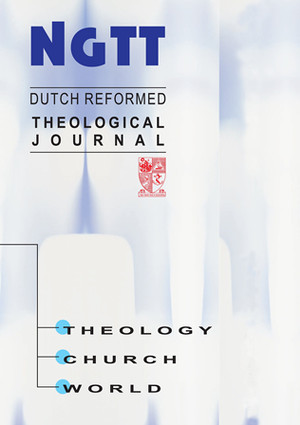Did Luther get it altogether wrong? Luther’s interpretation of the function of the Mosaic law in Galatians
DOI:
https://doi.org/10.5952/54-0-367Keywords:
Dirkie Smit, Herman Ridderbos, Luther, interpretationAbstract
While a student at the University of Stellenbosch in the 1970s, I struggled through Herman Ridderbos’ 600 page Paulus - Ontwerp van zijn Theologie (Paul – Design of his Theology). Halfway through the book a classmate, Dirkie Smit, came to my rescue by allowing me to have a look at some of his handwritten notes. These notes – and his verbal explanation, delivered in one late-night session – gave me the key to understand Ridderbos’ concerns. Suddenly I understood why Ridderbos used his first chapter to explain (and debunk most of) the different nineteenth- and twentieth-century schools of Pauline interpretation. I understood why the second chapter was one on Grondstructuren (foundations) and why the third chapter – in which Ridderbos really started to deal with the material from Paul’s epistles – was about “In leven in de zonde” (In living in sin). Ridderbos’ book introduced me to Paul and prompted me to reflect on the apostle in a way that eventually led me to do my postgraduate work in New Testament studies.For this and for much more I am grateful to Dirkie and delighted to offer these reflections on Paul as part of this volume in Dirkie’s honour. I have always thought Ridderbos’ interpretation of Paul (and why he interpreted him in the way he did) was the one which I understood reasonably well. This is not to say that I, in later years, did not on occasion wonder whether and to what degree the Ridderbos interpretation of Paul that I knew was the pure Paul of Ridderbos and not the Smit reading of the Paul of Ridderbos. This did not lessen my appreciation of Smit’s contribution to my thinking about these matters. It was his thoughts on the process of reading and interpretation – for example in his 2006 work Neem, lees! (Take, Read!) – that prompted me to reflect on Smit’s influence on my reading of Ridderbos’ Paul.
This brings me to the subject of this essay: the influence of reading strategies on the interpretation of texts. In recent Pauline studies the so-called Lutheran reading of Paul has been fiercely disputed. In my opinion, it would be fair to say that, despite staunch defenders, the tide is turning against the Lutheran reading. The question I turn to in this article is whether this tendency is justified, in other words: Was Luther’s interpretation a valid one?
Downloads
Published
2013-12-18
How to Cite
Wessels, F. (2013). Did Luther get it altogether wrong? Luther’s interpretation of the function of the Mosaic law in Galatians. NGTT | Nederduitse Gereformeerde Teologiese Tydskrif, 54(Supp 2), 321–331. https://doi.org/10.5952/54-0-367
Issue
Section
Articles | Artikels
License
Copyright of all NGTT material belongs to the Pieter de Waal Neethling Trust (PDWN Trust). The PDWN Trust is a trust fund established in 1932 with the aim of promoting quality theological research and publications.
The PDWN Trust pledges to maintain a legitimate scholarly record of the author's work and to defend the author's article against plagiarism and copyright infringement.
The PDWN Trust is committed to full Open Source publishing. This means that all articles published in NGTT will gradually be made freely available online. Authors maintain the right to:
- Share and self-archive their work.
- Make printed copies of their article for educational use.
- Present their article at a meeting or conference and distribute printed copies of the article
- Adapt and expand their published journal article to make it suitable for their thesis or dissertation.
- Republish the article (ensuring that the original article is cited as published in NGTT).
For any questions or queries in this regard, please contact the Editor.


